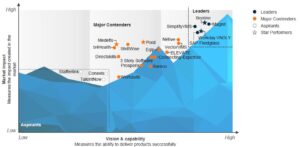The last two years have had many “never been seen before” moments, including the fact that HR leaders, procurement chiefs and even CFOs all agree on the top issue facing business today; talent shortages and recruitment. Over 60% of US businesses report a hiring shortage, and openings for recruiters on LinkedIn have surpassed openings for software engineers.
This brings the talent supply chain into laser focus. Talent acquisition teams need to hire better and faster, which requires differentiated sourcing channels and agile talent options. Hiring faster than your competition means having expert recruiting and staffing agencies actively looking for your next great hire, and giving them the mechanisms to do so.
Procurement teams managing staffing suppliers, consultants and freelance engagements will deliver better business outcomes if those resources are executing quickly, driving deliverables and bringing innovative ideas.
Imagine an environment in which these scenarios exist. It is possible.
In the early years of organizations adopting Vendor Management Systems (VMS) to manage contingent labor, there was a belief, real or perceived, that deploying a VMS inhibited supplier relationships and their ability to recruit. Today, not only are suppliers accepting a VMS platform as the cost of doing business, they welcome the benefits it brings.
Leveraging a VMS is a key component to ensuring access to a broad talent supply chain, and truly partnering with those resources.
Three ways a VMS enhances and supports the talent supply chain while improving performance
Recruitment partners and staffing suppliers get all the information they need, fast.
To recruit well in today’s environment, every component of the job requisition matters:
- A current, complete job description with a focus on key skills
- “Nice to have” versus “must have” criteria
- Details on the type of work and projects in scope
- Reporting structure, culture, and management styles
- Compensation, compensation, compensation
- Remote/ in-office work guidelines
- Career path opportunities
A VMS not only ensures each job requisition includes the required information through detailed job templates and guides, it releases that information in real time to all the staffing suppliers, recruitment partners, freelance systems or consultants that have been pre-identified as the best options for that requisition. This enables your partners to quickly and actively recruit or search their talent pools for the best possible fit for the role.
Additionally, the VMS enables all those recruiting for the position to track submittals and candidate feedback, which consistently rank as top elements of success in hiring the right candidate.
The visibility improves outcomes.
It is quite common today to hear business leaders say they are having trouble hiring. But very few can answer the question “How much longer is it taking to fill roles, and why?”.
As the old but lasting saying goes, “You can’t improve what you don’t measure” – Peter Drucker.
A VMS provides the entire organization with the ability to track numerous KPIs that identify gaps in the recruitment process and ultimately impact quality of hire.
- Submittal to hire
- Interview to hire
- Time to hire
- Time to onboard
- Turnover within 90 days
Monitoring these metrics can pinpoint recruitment bottlenecks that no company can afford in today’s environment. With clear data and trend information you are then able to have substantive discussions with staffing suppliers and hiring managers to determine the root cause for underperforming KPIs, and drive improvements.
Transforms supplier relationships and paves the way for innovation.
The end-to-end automation, data, and detailed reporting a VMS provides simplifies the management of the day-to-day tactics of supplier management.
Once a supplier has been approved to do business with your organization, all relevant factors of the relationship can be built into the VMS. Compliance requirements such as screenings are built into submittal checklists. Pricing is regulated by rate cards that are built into the system for each type of requirement. KPIs can be reported on with the click of a button. And, billing compliance is managed through invoice reporting. No longer does the procurement or supplier management team have to spend time tracking contract compliance, and suppliers have to spend no time on creating ad hoc reports for quarterly meetings.
Gone are the days when a VMS inhibited the ability to interact directly with suppliers. In fact, a VMS transforms supplier meetings from transactional compliance reviews to strategic sessions. A review of what the data is indicating in terms of trends and root causes drives process improvements. And together the discussion becomes more about the partnership. What insights do suppliers have, what can you share about the organization’s talent roadmap, how to get ahead of market trends, how to pipeline talent, and what improvements are needed in the marketplace around brand and employer value proposition?
It is these types of discussions that a VMS enables, and will put your organization in a better position to hire better talent, faster than your competition.
For more information on how ELEVATE VMS, can help improve your results, contact us today.





